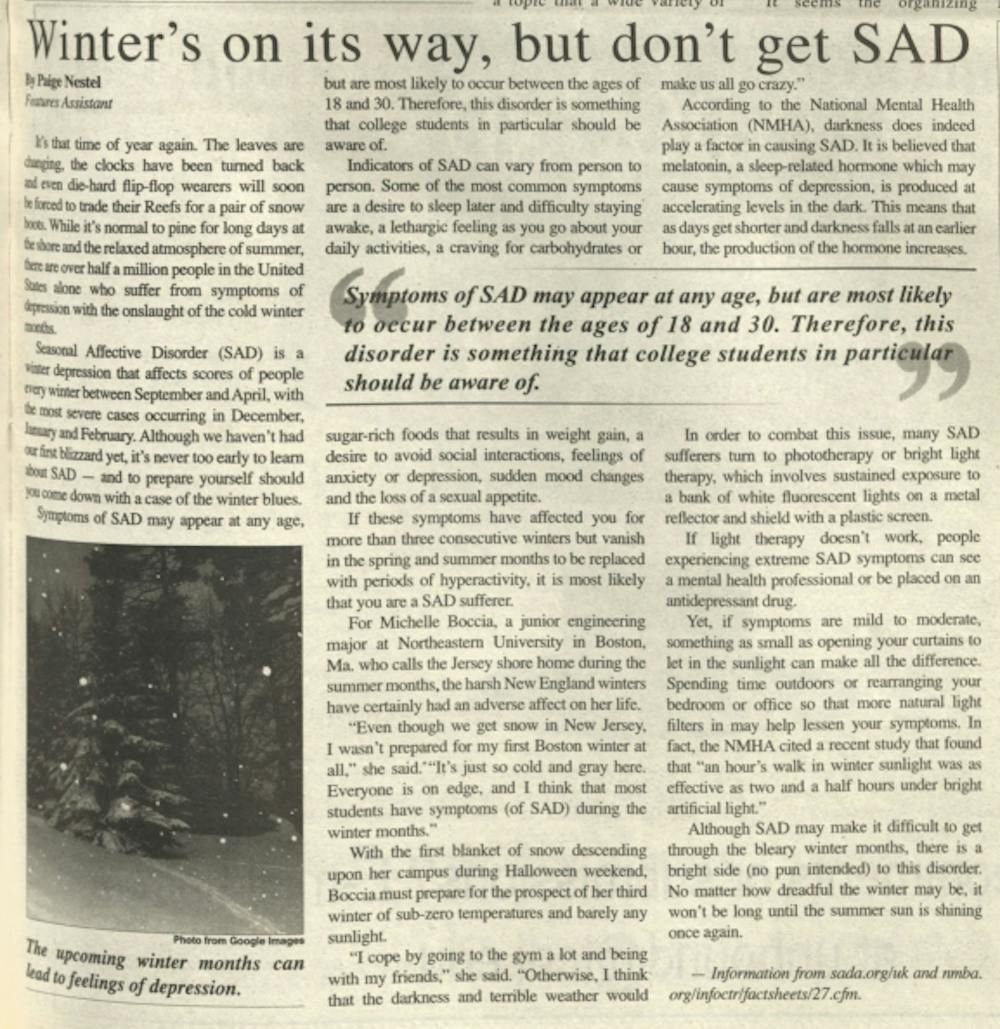As the days become shorter and the weather gets colder, students may find that motivation drops and feelings of fatigue and hopelessness increase. It is that time of year when midterms, projects, papers and exams are coming about, and it’s normal to feel anxious about upcoming deadlines. However, there are a few students who may feel mentally impaired beyond those feelings of stress, which can result from seasonal affective disorder.
In a November 2005 issue of The Signal, a reporter writes about the symptoms of SAD and remedies to combat this seasonal disorder.
It's that time of year again. The leaves are changing, the clocks have been turned back and even die -hard flip-flop wearers will soon be forced to trade their Reefs for a pair of snow boots. While it's normal to pine for long days at tie shore and the relaxed atmosphere of summer, there are over half a million people in the United States alone who suffer from symptoms of depression with the onslaught of the cold winter months.
Seasonal Affective Disorder (SAD) is a winter depression that affects scores of people every winter between September and April, with the most severe cases occurring in December, January and February. Although we haven't had our first blizzard yet, it's never too early to learn about SAD — and to prepare yourself should you come down with a case of the winter blues.
Symptoms of SAD may appear at any age, but are most likely to occur between the ages of 18 and 30. Therefore, this disorder is something that college students in particular should be aware of.
Indicators of SAD can vary from person to person. Some of the most common symptoms are a desire to sleep later and difficulty staying awake, a lethargic feeling as you go about your daily activities, a craving for carbohydrates or sugar-rich foods that results in weight gain, a desire to avoid social interactions, feelings of anxiety or depression, sudden mood changes and the loss of a sexual appetite.
If these symptoms have affected you for more than three consecutive winters but vanish in the spring and summer months to be replaced with periods of hyperactivity, it is most likely that you are a SAD sufferer.
For Michelle Boccia, a junior engineering major at Northeastern University in Boston, Ma. who calls the Jersey shore home during the summer months, the harsh New England winters have certainly had an adverse affect on her life.
"Even though we get snow in New Jersey, I wasn't prepared for my first Boston winter at all," she said." "It's just so cold and gray here. Everyone is on edge, and I think that most students have symptoms (of SAD) during the winter months."
With the first blanket of snow descending upon her campus during Halloween weekend, Boccia must prepare for the prospect of her third winter of sub-zero temperatures and barely any sunlight.
"I cope by going to the gym a lot and being with my friends," she said. "Otherwise, I think that the darkness and terrible weather would make us all go crazy."
According to the National Mental Health Association (NMHA), darkness does indeed play a factor in causing SAD. It is believed that melatonin, a sleep-related hormone which may cause symptoms of depression, is produced at accelerating levels in the dark. This means that as days get shorter and darkness falls at an earlier hour, the production of the hormone increases.
In order to combat this issue, many SAD sufferers turn to phototherapy or bright light therapy, which involves sustained exposure to a bank of white fluorescent lights on a metal reflector and shield with a plastic screen.
If light therapy doesn't work, people experiencing extreme SAD symptoms can see a mental health professional or be placed on an antidepressant drug.
Yet, if symptoms are mild to moderate, something as small as opening your curtains to let in the sunlight can make all the difference. Spending time outdoors or rearranging your bedroom or office so that more natural fight filters in may help lessen your symptoms. In fact, the NMHA cited a recent study that found that "an hour's walk in winter sunlight was as effective as two and a half hours under bright artificial fight."
Although SAD may make it difficult to get through the bleary winter months, there is a bright side (no pun intended) to this disorder. No matter how dreadful the winter may be, it won't be long until the summer sun is shining once again.







